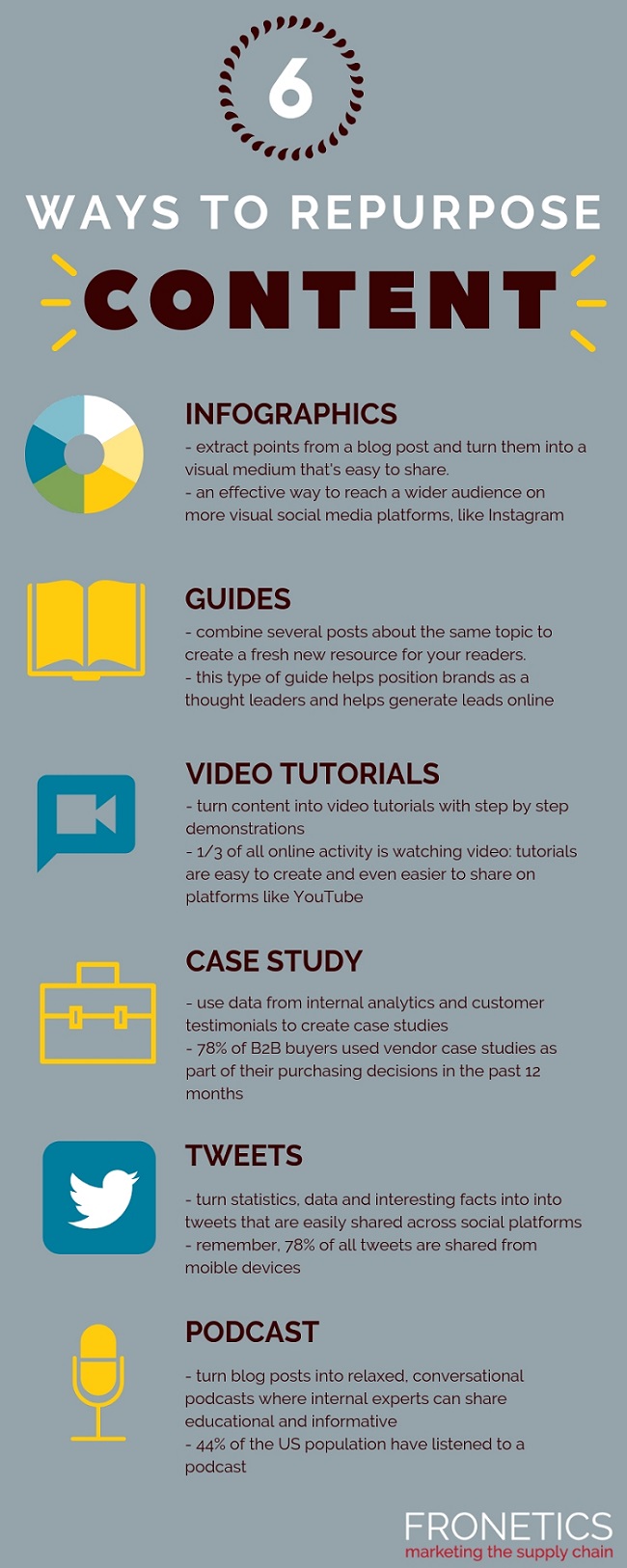
by Fronetics | Jan 8, 2019 | Blog, Content Marketing, Logistics, Marketing, Strategy, Supply Chain
Before you make your marketing resolutions for this year, take a moment to look at last year’s digital content marketing successes and failures.
As the new year begins, take the opportunity to look at past marketing choices, see what worked and what didn’t, and shape goals for the future. The year ahead is a blank canvas, but evaluating past successes and missteps is key to making sure the big picture works.
Writing for Forbes Communication Council, Senior Digital Marketing Manager at Caring People Inc. Karina Tama-Rutigliano offers these four tips for successfully moving forward with digital marketing.
1) Don’t go anywhere without clear, specific goals — and a plan for measuring results.
Assuming you’ve been tracking useful metrics along the way, the end of the year means you’re armed with a fresh crop of data. Take time to study and evaluate your data, and use it to develop incremental goals, as well as projections for next year. If you haven’t already, now is a good time to implement a documentation strategy, like our Monthly Marketing Report Template.
Furthermore, take a moment to consider how the metrics you’re currently tracking are serving you. Is your data giving you the insights you need? Are you left with questions about where your efforts are successful, or where another approach is needed? The beginning of the year is a good time to tweak your plan for tracking and measuring the results of your digital marketing efforts.
2) Don’t forget the “social” in social media.
[bctt tweet=”Social media platforms are viable places to engage with your customers,” writes Tama-Rutigliano. This means encouraging interaction with your posts, replying to comments, and engaging with posts from your community.” username=”Fronetics”]
You’re so busy creating and curating content to be fresh, relevant, and engaging for your social media audience, you forget that one crucial part of social media marketing: the social. “Social media platforms are viable places to engage with your customers,” writes Tama-Rutigliano. This means encouraging interaction with your posts, replying to comments, and engaging with posts from your community — be part of the conversation, and build relationships.
3) Don’t put all your eggs in one basket.
With so many options for digital marketing, all of them full of possibilities, it can be tempting to choose one or two and put all your dollars and efforts there. But a successful digital content marketing strategy is robust and well-rounded. Use your year-end data to evaluate where your efforts are thriving, and where you need to devote some cash and ideas.
4) Don’t post without a purpose.
We’ve all felt the push to create content, just for the sake of getting something new up on the blog or social media platforms. But content without a clear purpose in mind is never going to get you the best results.
It’s easy to get cynical, and think that content creation is just about feeding the search engine beast. But the heart and soul of content marketing is about sharing your knowledge and expertise with your customer-base, building trust, and creating lasting relationships.
Related posts:


by Fronetics | Dec 10, 2018 | Blog, Content Marketing, Data/Analytics, Logistics, Marketing, Strategy, Supply Chain
Here are our most-viewed blog posts from 2018 about analytics and ROI, including articles about how to calculate your marketing ROI and competitive benchmarking.
Content marketing is increasingly popular in the B2B sector. In fact, 91% of B2B marketers used content marketing as a part of their strategy last year. But marketers still struggle with proving the return on investment.
Evaluating your analytics gives you valuable insight into what’s working (and what’s not) with your content marketing strategy. But 47% of B2B marketers reported not measuring content marketing ROI. And of those marketers, 86% sited lack of knowledge, time, and convenience for reasons why their company doesn’t calculate ROI.
[bctt tweet=”47% of B2B marketers reported not measuring content marketing ROI. And of those marketers, 86% sited lack of knowledge, time, and convenience for reasons why their company doesn’t calculate ROI.” username=”Fronetics”]
This year, Fronetics examined new analytics tools and numerous ways to calculate ROI — within the context of supply chain and logistics operations, as well as how these methods can be used to improve overall marketing performance. Here’s a look at our most viewed analytics and ROI posts in 2018.
Top 5 analytics and ROI posts
1. The Art of Measuring Podcast Success
Podcasts are an increasingly popular content medium, but measuring their performance is difficult. Here are some tips for measuring podcast success in spite of the challenges. Spoiler alert: it’s an art, not a science. Today’s busy professionals are increasingly driven to make their “down time” more productive and engaged. The popularity of podcasts rises every year, with more than 50% of American homes now classified as “podcast fans” by Nielsen. Read full post
2. Top 10 Social Media Analytics Tools
Analyzing your social media performance is critical to a successful marketing effort, especially in light of recent changes to Facebook’s News Feed. You need the tools to determine what’s working and what isn’t, as well as the best time to post your content for your target audience. At Fronetics, we use a variety of tools to measure social media success. Here are our 10 favorite social media analytics tools. Read full post
3. 4 Metrics to Measure the Impact of Content Marketing on Brand Awareness
A successful content marketing strategy strengthens the relationship between brands and their target audiences. And brand awareness is a key component to any successful content marketing strategy. Ultimately, the more aware audiences are of your brand, the more likely they are to buy your products or services. Read full post
4. Use These Metrics to Benchmark Marketing Performance against Your Competitors
Competitive benchmarking is the process of comparing your company’s performance against that of your competitors. You can use various metrics to benchmark what these businesses are doing better than you are and where you have the edge. Benchmarking marketing performance is an important step in the process of evaluating the success of your content marketing strategy. Read full post
5. Infographic: 4 Ways to Measure Blogging ROI
Why do you blog? It seems like a simple question, but the answer has a huge impact on the content you produce and the outcome of your efforts. As with all aspects of your business, you should give the return on investment of your content marketing efforts ample attention. That is especially true for blogging ROI, if generating new business is indeed one of the reasons you blog in the first place. Read full post
Related posts:


by Elizabeth Hines | Dec 6, 2018 | Blog, Content Marketing, Current Events, Logistics, Marketing, Social Media, Strategy, Supply Chain
As content marketing continues to increase in popularity, here are six trends to consider when planning your 2019 strategy.
A recent article by Forbes on content marketing notes: “As recently as a few years ago, marketers handled content mostly as a side project. It was more of a bonus than an essential role — something you did when you had time because it took a backseat to more traditional marketing projects and responsibilities. That’s changed.”
Boy, has that changed. The content marketing industry is expected to be worth more than $400 billion by 2021.
The 2018 report from the Content Marketing Institute shows just how prevalent content marketing is, and how essential it has become to creating brand awareness, educating your audience, and building credibility and trust with your customers.
Supply chain & logistics marketers: Trends to watch
So, where is content marketing headed in 2019? Content marketing budgets are still on the rise, and supply chain and logistics companies are increasingly seeing the value in moving to an inbound marketing strategy driven by original content.
These are the six notable trends to consider when planning your 2019 content marketing strategy.
1. Video
Video is currently the most popular form of content being consumed online today, and video marketing will continue to have substantial value in 2019.
Smart supply chain marketers should start the new year by developing a visual storytelling strategy that offers consistent delivery of valuable content.
What’s your best bet? Be helpful and teach your audience something worthwhile to them.
2. Chatbots
The rise of chatbots – automated computer programs that simulate human conversation in messaging apps – is expected to continue in 2019. Business Insider recently reported that the number of people on messaging apps surpassed the number of users on social networks!
[bctt tweet=”Business Insider recently reported that the number of people on messaging apps surpassed the number of users on social networks!” username=”Fronetics”]
Chatbots are just one of the ways artificial intelligence will shape the content marketing landscape in 2019, but their ability to drastically increase customer engagement puts them on the short list for a major trend to watch in the coming year.
3. Voice search
Voice search is becoming an increasingly prevalent means of attaining information. Statistics vary, but it’s expected that anywhere between 30-50% of all searches will be voice searches by 2020. A recent report by NPR and Edison Research found that the rise of smart speakers is substantially changing consumer routines and purchasing behavior.
A good content marketing strategy for 2019 should consider how your customers might use voice search in your industry, and what you can do to maximize your content’s ability to respond.
4. Long-form content
I love this one, because it harkens back to humble beginnings of content marketing and the desire to put informative, quality content in front of a targeted interested audience.
Long form content – white papers, case studies, and lengthier blog posts e.g. – will have a resurgence of renewed appreciation in 2019. Why? Because many industries, including supply chain and logistics industries, are saturated with tons of mediocre short form content. People are increasingly looking to weed through it all for substantial quality posts from trusted sources. In addition, search engines will favor longer posts in results rankings.
Cheers to 2019 being the year of quality over quantity!
5. Brand ambassadors
We wrote about brand ambassadors as we headed into 2018, but they are worth mentioning again as we look forward to 2019. Brand ambassadors are employees that influence the B2B buying decisions of others, and they are an often-overlooked resource with more traditional marketing tactics.
Peers and colleagues are the third most influential source of information for business to business (B2B) purchasing, right behind online searches and your website! And there’s nothing more credible than a friend who speaks highly of their company’s product or service.
Definitely consider how you can help make brand ambassadors out of your employees in 2019.
6. Market Influencers
The final trend to watch in 2019 is influencer marketing, a form of marketing which focuses on influential people rather than the market as a whole.
Basically, marketers identify individuals who might have influence over potential buyers and create marketing campaigns and activities around these influencers. In many ways, this works similarly to a brand ambassador, where a single person influences their network of friends; in this case, however, the market influencer has a large network and a lot of “friends” who listen.
Influencer marketing will be a huge trend in marketing for 2019, and it would be worth considering who might be an influencer in your industry in the coming year and what your company might do reach them.
So, there you have it. As we head into 2019, these are the trends to watch and plan for in content marketing space.
The B2B buying climate is growing longer and more complex, and content marketing is so effective throughout the entire sales cycle if it’s done well. The end of the year is a great time to revisit your marketing strategy and make any necessary changes for the coming year.
Best wishes in the year ahead!
This post originally appeared on EBN Online.
Related posts:


by Fronetics | Dec 4, 2018 | Blog, Content Marketing, Logistics, Marketing, Strategy, Supply Chain
Repurposing content is an efficient way to reach a broader audience and build brand awareness.
You spent hours pouring over stats and interesting facts for a blog post. Don’t let all of that effort fall to the wayside. Breathe new life — and reach new audiences — by repurposing that content into engaging new formats.
Some social users like video, while others prefer pictures or podcasts. Taking content and changing its original format is just smart business. Repurposing high-quality content saves marketers time and money and helps to reach a broader audience.
Be picky
Not all of your blog posts and content get the same attention, and that’s ok. Some pieces will resonate more, increasing engagement and driving website traffic.
Run analytics on your content and see what pieces have performed the best. Use tools like Google Analytics to determine your most popular blog posts, your most engaged tweets, or your most viewed videos. This data will help you decide which content should be repurposed. The idea is to take one piece of content and gain visibility and expand your audience by turning it into multiple pieces of content.
The Rule of 7
Repurposing content isn’t just about cutting and pasting content. Have you heard of the Rule of 7? The Rule of 7 is a marketing principle that states your prospects need to encounter your content seven times before they take notice. That’s right, seven times.
[bctt tweet=”The Rule of 7 is a marketing principle that states your prospects need to encounter your content seven times before they take notice. That’s right, seven times.” username=”Fronetics”]
Repurposing content is a great way to take high-quality content and continue to get it in front of audiences without seeming redundant. HubSpot reports that brands who blog around 16 times or more per month get 3.5 times more traffic and 4.5 times more leads than businesses that blog fewer than four times a month. Frequency clearly gets results, but it can also be incredibly time-consuming to create new content 16 times every month. Repurposed content can help your marketing team increase frequency while focusing on quality.
Infographic: 6 ways to repurpose content

(Made with Canva)
Takeaway
How much value does your company put on content? It may be even more important than you think. Use these tips to repurpose high-quality content or yet better, start creating content with these tips in mind. Thinking about a topic and how you can turn that topic into multiple pieces of content will help your hard work go further and perform better.
Related posts:


by Jennifer Hart Yim | Nov 28, 2018 | Blog, Content Marketing, Logistics, Marketing, Strategy, Supply Chain, Talent
Great people don’t always focus on expressing their superpowers at work out of a fear of limiting their scope. Here’s how employers can identify and coach employees to work to their fullest potential.
This guest post comes to us from Argentus Supply Chain Recruiting, a boutique recruitment firm specializing in Supply Chain Management and Procurement.
In people management and hiring, we might assume that we’re emphasizing what our employees are best at. “Play to your strengths” is one of the biggest truisms of business, and life in general. If the people we’re managing – or hiring – are talented, we might assume that they’re working to their full potential in their roles. The cream rises to the top in any organization, but how often are we failing to hire and manage talented people based on what they’re truly best at?
A great new article from executive coach Whitney Johnson in the Harvard Business Review details how employers can help their teams play to their strengths. More than strengths, actually: Johnson offers strategies for identifying and coaching employees based on their superpowers – the things that come most easily, the things that those employees are not always willing to boast about.
[bctt tweet=”People sometimes undervalue their own superpowers because the tasks associated with them feel “too easy” compared to hard-won skills. But let people focus on their superpowers and real opportunities for innovation start to spring forth.” username=”Fronetics”]
As Johnson puts it, people sometimes undervalue their own superpowers because the tasks associated with them feel “too easy” compared to hard-won skills. But let people focus on their superpowers and real opportunities for innovation start to spring forth.
Often you can spot superpowers in the wild; some people are such high performers that it’s obvious what they’re best at, and they’ve found their way into a role that utilizes those skills. But the HBR article makes the point that great people don’t always focus on expressing their superpowers at work out of a fear of limiting their scope. It’s rare that you find someone who’ll put what they’re truly a genius at on their resume – either out of a desire not to boast, or to present a more balanced profile.
The article identifies some strategies for managers to identify their team’s “superpowers.” They encourage managers to ask their employees a few key questions:
- What exasperates you? Ask people if there’s anything in their job that frustrates them when other people don’t understand it easily.
- What compliments do you dismiss? The article makes a great point that people tend to downplay the things that they’re best at – the things that come most naturally to them – out of humility or because they feel “easy.” If someone regularly dismisses compliments around a certain task or deliverable, that’s a sign that thing might be their superpower.
- What do you think about when you have nothing to think about? In downtime, our brains regularly come back to the things that stimulate us most – the things our minds gnaw at that we can’t let go. Leaders should try to find out their employees’ fixations, because – through coaching – these can develop into passions and ultimately superpowers.
But why stop at coaching and development? We think that companies should strive to adopt this approach for hiring as well: as much as possible they should hire employees for their superpowers, rather than their ability to carry out an over-wide range of tasks.
For example, in Strategic Procurement: is someone particularly elite at communicating and building relationships? Assign them specifically to build buy-in from internal stakeholders across the business, and act as a point-person between those internal clients and the sourcing group. Leave the sourcing to those whose “superpowers” are evaluating the supplier marketplace, or negotiation, rather than structuring your department around a bunch of generalists.
Does someone have a deep understanding of a particular category, for example marketing spend, perhaps from working on the other side of the fence? Hire them for that category. These are just a few examples of how we think companies can adopt the “superheroes” approach to hiring.
Companies should tailor job descriptions towards key deliverables, and consider including the questions mentioned above in the job interview process, as a means of trying to uncover what comes easiest to job candidates – which also happens to be the areas where they’re most likely to innovate.
Budgets, organizational structure, and directives from senior leadership will often be impediments to this approach, but specialization is the name of the game in improving efficiency, which is after all what Supply Chain Management and Procurement are all about.
Related posts:


by Fronetics | Nov 20, 2018 | Blog, Content Marketing, Data/Analytics, Logistics, Marketing, Strategy, Supply Chain
Finding, analyzing, and using the right metrics effectively is crucial to a successful content marketing strategy.
Accountability and showing a solid return on investment is everything when it comes to ensuring that your business is allocating adequate resources to marketing. And let’s face it, too many executives think that marketing is, at best, about supporting sales or, at worst, a department that exists to paste logos onto coffee mugs.
Writing for Marketo, Content Marketing Specialist Bryson Runser points out that as an “informed marketer, it’s your duty to infuse credibility into your organization by way of meaningful metrics that tie directly to your top and bottom line.” While the C-suite famously cares nothing about internal marketing metrics like Facebook likes or click-through rate, metrics are crucial to the success of marketing the supply chain. Not only that, effective use of metrics is the best way to establish the function and importance of the marketing department within your organization.
[bctt tweet=”Effective use of metrics is the best way to establish the function and importance of the marketing department within your organization.” username=”Fronetics”]
Numbers don’t lie
One of the main aspects of the “crisis of accountability” is a problematic view of what marketing is: “if marketing leaders insist that marketing is an art and not a science,” Runser writes,” then the department will remain isolated from other groups.” Establishing that content marketing is not only dependent upon data, but can also be measured, is key to changing that perception.
“Marketing must be able to justify their expenditures as investments in revenue and growth,” writes Runser. Of course, it’s partly a chicken-and-egg issue, since getting to the point of being able to talk about expenditures in this way does require investment from the top of your business.
We know that measuring the impact of content marketing can be tricky. But it’s not impossible. The first step is determining the right metrics to track. For more detailed ideas and analysis, check out this post, which details how to determine and use metrics to measure the impact of content marketing on brand awareness.
Why are you reporting?
Collecting and reporting on marketing ROI can feel like you’re spinning your wheels and collecting meaningless data. But it’s crucial to keep metrics focused on the main goal: to enable you and your business to make decisions that improve your marketing efforts. “This is the difference between backward-looking measurement and decision-focused management,” says Runser.
Data for the sake of data doesn’t do any good. Data should be used to shape insights, which in turn informs priorities and actions for your business. We’ve written before about the danger of vanity metrics, which have no bearing on your bottom line but can give you an inflated sense of success.
It’s very easy to fall into the trap of meaningless data collection, especially when marketers are often struggling to prove their worthiness to the C-suite. But using metrics to improve marketing’s performance will go a long way towards winning over executives. “[B]y aligning data measurements with your company’s strategic objectives,” Runser writes, “it will be easier to allocate resources by revenue impact.”
Related posts:













